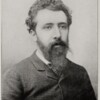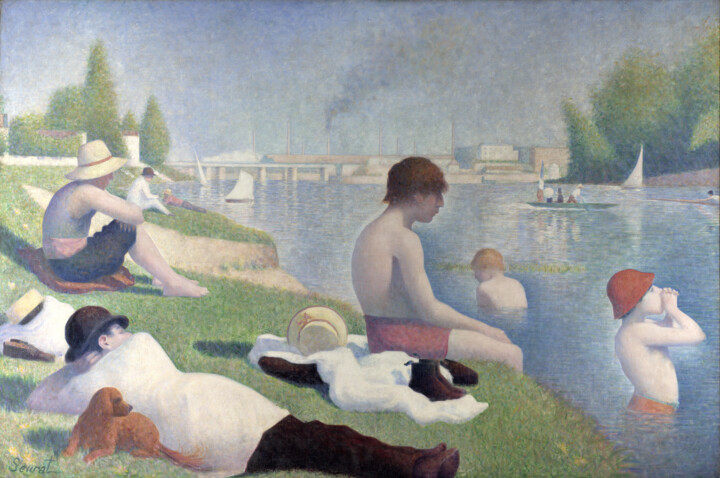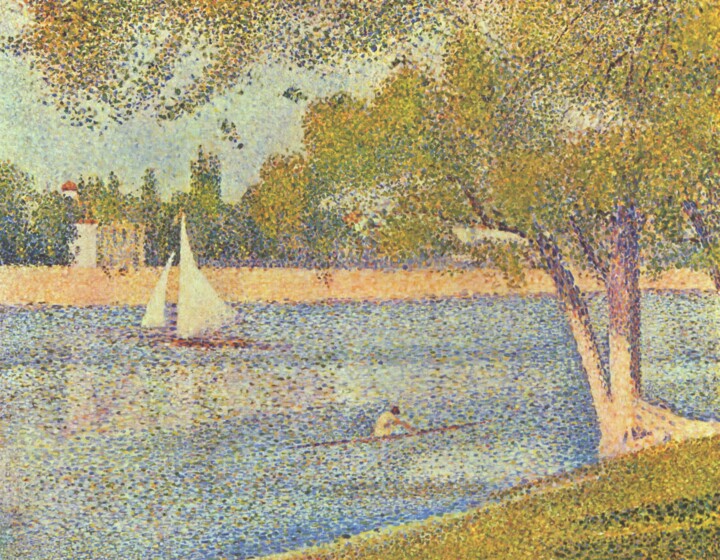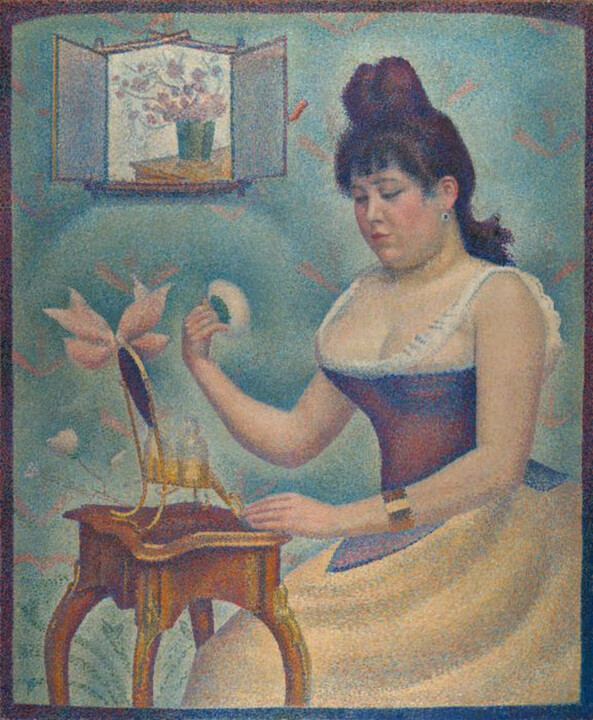 Georges Seurat, 1888
Georges Seurat, 1888
Life and work of Georges Seurat
Georges Seurat was born on December 2, 1859, in Paris, France. The family lived in a working-class neighborhood in Paris. Seurat showed an early interest in art, and his parents encouraged him to pursue his passion. He attended the École Municipale de Sculpture et Dessin, where he learned drawing and painting. Later, he attended the École des Beaux-Arts in Paris, but left before completing his studies.
During his time at the École des Beaux-Arts, Seurat became interested in the scientific principles of color and light, which would later become the basis of his artistic style. He also studied the works of Old Masters and Impressionist painters, which influenced his artistic development. However, he wanted to take the use of color and light in painting to a new level.
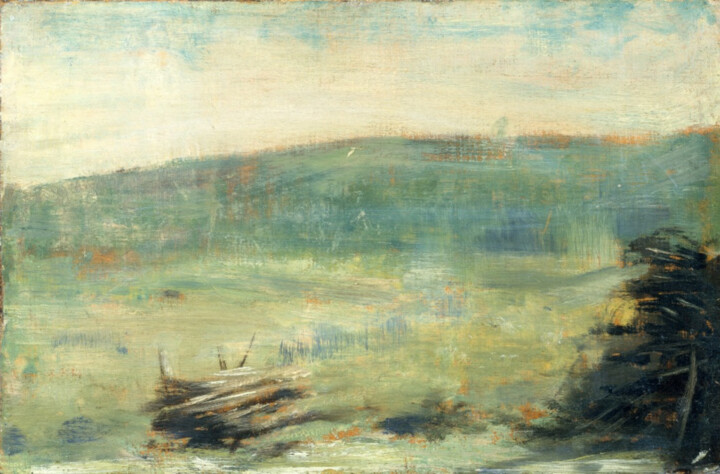 Georges Seurat - Landscape at Saint-Ouen, 1878-79. Oil on panel. Metropolitan Museum of Art
Georges Seurat - Landscape at Saint-Ouen, 1878-79. Oil on panel. Metropolitan Museum of Art
Despite his artistic pursuits, Seurat was required to complete his military service, which he did from 1879 to 1880. During his service, he continued to sketch and draw, and even produced a series of caricatures of his fellow soldiers.
After completing his military service, Seurat continued to develop his artistic style and techniques. He was a meticulous and disciplined artist, often spending months or even years on a single painting. Seurat's dedication and hard work paid off, as he became one of the most influential artists of his time.
In the later years of his career, Georges Seurat continued to explore the possibilities of pointillism and Divisionism. This technique involved applying small dots of pure color to the canvas, which the eye blends together to create a unified image. Seurat believed that this method could create a more vibrant and luminous image than traditional painting techniques. He continued to refine his techniques and experimented with different subject matters, including urban scenes, landscapes, and portraits.
 Georges Seurat - Models (Les Poseuses), 1886–88. Barnes Foundation, Philadelphia
Georges Seurat - Models (Les Poseuses), 1886–88. Barnes Foundation, Philadelphia
During this period, Seurat produced some of his most famous works, including "A Sunday Afternoon on the Island of La Grande Jatte" (1884-1886), "Bathers at Asnières" (1884), and "The Circus" (1891). "Bathers at Asnières" was initially rejected by the Paris Salon but was later exhibited in the eighth and final Impressionist exhibition in 1886.
In 1884, Seurat began working on his masterpiece, "A Sunday Afternoon on the Island of La Grande Jatte". The painting, which took him two years to complete, depicts a scene of leisure in a Parisian park, featuring fashionable men and women relaxing on a grassy lawn. His pointillism technique was a radical departure from the traditional method of mixing colors on a palette before applying them to the canvas. Instead, he used dots of pure color, arranged in a precise pattern, to create the desired effect.
During his mature period, Seurat also became interested in color theory and the scientific principles of color and light. He read extensively on the subject and incorporated his knowledge into his paintings.
Seurat was fascinated by the science of optics and color perception, and he believed that Pointillism was a more accurate way of representing light and color in art. He even developed a system of color theory called "chromoluminarism" to explain how colors interact with each other.
 Georges Seurat - Circus Sideshow, 1887–88. Oil on canvas. Metropolitan Museum of Art, New York
Georges Seurat - Circus Sideshow, 1887–88. Oil on canvas. Metropolitan Museum of Art, New York
In his personal life, Seurat was known to be reserved and somewhat reclusive. He had a few close friends, including the artist Paul Signac, who shared his interest in color theory and pointillism. Seurat never married, but he did have a common-law wife named Madeleine Knobloch.
In his late period he had begun to move away from the strict application of pointillism and was starting to use more fluid brushstrokes, indicating a potential shift in his style.
One of the most notable works from this period is "The Circus," completed in 1891, which shows the influence of Seurat's evolving technique. This painting depicts a group of performers and animals in a circus ring, and it is notable for its use of light and shadow to create depth and texture. The colors are more muted than in his earlier works, and the brushstrokes are looser and more fluid, indicating a departure from the rigid application of pointillism.
Seurat was also interested in exploring the possibilities of portraiture during this period. He completed a few portraits of his family and friends, including his mother and his common-law wife, Madeleine Knobloch.
 Georges Seurat - Le Chahut (The Can-can), 1889–90. Oil on canvas. 170 x 141 cm. Kröller-Müller Museum, Otterlo
Georges Seurat - Le Chahut (The Can-can), 1889–90. Oil on canvas. 170 x 141 cm. Kröller-Müller Museum, Otterlo
Georges Seurat died on March 29, 1891, at the age of 31, from an illness that is believed to have been meningitis. Despite his short career, Seurat's innovative style and techniques had a profound influence on the development of modern art, and he is considered one of the most significant figures in art history.
Today, Seurat's work is celebrated for its technical brilliance, innovative use of color, and ability to capture the essence of modern life. He was a key figure in the Post-Impressionist movement, which sought to move beyond the fleeting impressions of the Impressionists and create more enduring, structured works of art. His influence can be seen in the work of many later artists, including Pablo Picasso, Henri Matisse, and Vincent van Gogh.
Seurat's color theory
Georges Seurat developed a system of color theory called "chromoluminarism" or "divisionism". This theory was based on the idea that colors could be made more vibrant by juxtaposing small dots of pure color, rather than mixing them on a palette. Seurat believed that this approach produced a more accurate representation of light and color in art.
According to Seurat's theory, color was made up of three components: luminosity, hue, and saturation. He believed that the way these components interacted could be controlled by the artist through the use of small dots of pure color.
Seurat's use of complementary colors was also an important part of his color theory. He believed that by placing complementary colors next to each other, they would enhance each other's vibrancy and create a greater sense of depth and contrast in the painting.
Seurat's color theory was not just a scientific approach to painting, but also a philosophical one. He believed that color was a language that could express emotions and ideas, and that the careful use of color could help to convey the mood and meaning of a painting.
Seurat's influence can be seen in the work of many later artists, including the Neo-Impressionists, who adopted his Pointillism technique, as well as the Fauvists and Cubists, who were inspired by his use of color.
In addition to his technical innovations, Seurat's approach to subject matter was also significant. He was interested in depicting modern life in his paintings, and his works often featured scenes of everyday people engaged in leisure activities.
Important art by Georges Seurat
Seurat's work is characterized by his innovative use of color and composition, as well as his interest in depicting modern life. Some of his most notable pieces include:
“A Sunday Afternoon on the Island of La Grande Jatte” (1884-1886) - This large-scale painting is perhaps Seurat's most famous work. It depicts a group of people enjoying a leisurely afternoon on an island near Paris and is notable for its use of Pointillism and its depiction of modern life.
Seurat's painting, “Sunday Afternoon on the Island of La Grande Jatte”, was a significant work that was showcased in the eighth and final Impressionist exhibition in 1884. Its exhibition later that year at the Sociéte des Artistes Indépendants resulted in critique Félix Fénéon coining the term 'Neo-Impressionism'. This painting marked the start of a new primitivism in Seurat's work, inspired by popular art and a desire to depict modern life through the organization of harmonies.
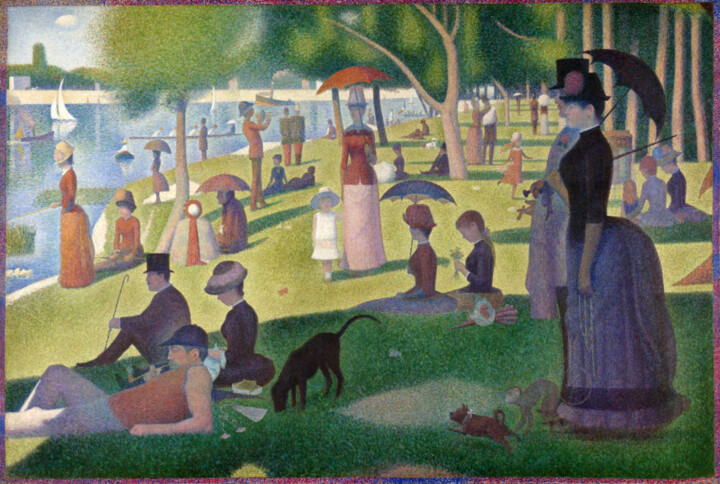 Georges Seurat - A Sunday Afternoon on the Island of La Grande Jatte, 1884–86. Oil on canvas, 207.5 × 308.1 cm. Art Institute of Chicago
Georges Seurat - A Sunday Afternoon on the Island of La Grande Jatte, 1884–86. Oil on canvas, 207.5 × 308.1 cm. Art Institute of Chicago
“Bathers at Asnières” (1884) - This painting features a group of working-class men enjoying a day by the river. The composition and use of color in the painting were both innovative for the time. In “Bathers at Asnières” Seurat aimed to combine classicism with modern, quasi-scientific approaches to color and form. Seurat's palette, although bright, is not Impressionistic in its approach to capturing a fleeting moment. Instead, he meticulously employs shades of a single hue, as seen in the influence of Eugene Delacroix's work. The figures in the painting are working-class, a significant departure from the bourgeois types depicted by Monet and Renoir in the 1870s.
 Georges Seurat - Bathers at Asnières, 1884. Oil on canvas. 201 × 301 cm. National Gallery, London
Georges Seurat - Bathers at Asnières, 1884. Oil on canvas. 201 × 301 cm. National Gallery, London
“The Circus” (1890-91) - In “The Circus” there is a scene of dynamic movement that reflects his late style. The inspiration for the scene came from an anonymous poster for the Nouveau Cirque, which was printed in 1888, though the horse and bareback rider were reversed. A figure in the first row of seats, with a silk hat and a visible lock of hair underneath it, is Charles Angrand, Seurat's friend who was a painter. This painting was Seurat's final work, left incomplete when he died unexpectedly in March 1891. Shortly after, it was sold to Seurat's friend, Paul Signac.
 Georges Seurat - The Circus, 1891. Oil on canvas. Musée d'Orsay, Paris
Georges Seurat - The Circus, 1891. Oil on canvas. Musée d'Orsay, Paris
“Young Woman Powdering Herself” (1888-90) - The painting portrays Seurat's mistress, Madeleine Knobloch, and shows his deep admiration for her. Seurat deliberately contrasts the classical formality of the figure with the light, playful Rococo background. This work also reflects Seurat's growing fascination with caricature and popular art, which gave his paintings a new expressiveness that aligned with the contemporary interest in Symbolism.
 Georges Seurat - Young Woman Powdering Herself, 1888–90. Oil on canvas. Courtauld Institute of Art
Georges Seurat - Young Woman Powdering Herself, 1888–90. Oil on canvas. Courtauld Institute of Art
“Port-en-Bessin, Entrance to the Harbor” (1888) - It depicts the entrance to the small fishing port of Port-en-Bessin in Normandy, France. Seurat used his pointillist technique to create a shimmering effect of sunlight reflecting off the water and the boats in the harbor. The painting is characterized by a muted color palette, with shades of blue and green dominating the scene. It is considered one of Seurat's finest seascapes and is part of the collection at the Musée d'Orsay in Paris.
The Legacy of Georges Seurat
The legacy of Georges Seurat is significant, both in terms of his artistic innovations and his impact on the development of modern art.
Seurat's Pointillism technique was a major innovation in the world of art. This technique allowed for a greater level of control over color and produced a more vibrant and luminous effect.
Seurat's color theory, which he called "chromoluminarism," was also groundbreaking. His belief that colors could convey meaning and emotion was a major departure from traditional approaches to color in art, and his use of complementary colors to create contrast and depth inspired many later artists.
Seurat's influence can be seen in the work of many artists who came after him, including the Neo-Impressionists, Fauvists, and Cubists. His use of color and his interest in modern life as a subject matter were particularly influential.
In addition to his artistic contributions, Seurat's legacy also includes his role in the development of the avant-garde. His rejection of traditional academic approaches to art and his interest in exploring new techniques and ideas helped to pave the way for future generations of artists.
Overall, the legacy of Georges Seurat is one of innovation, experimentation, and a commitment to pushing the boundaries of what was possible in art. His influence can still be felt in the work of contemporary artists today.


 Selena Mattei
Selena Mattei
